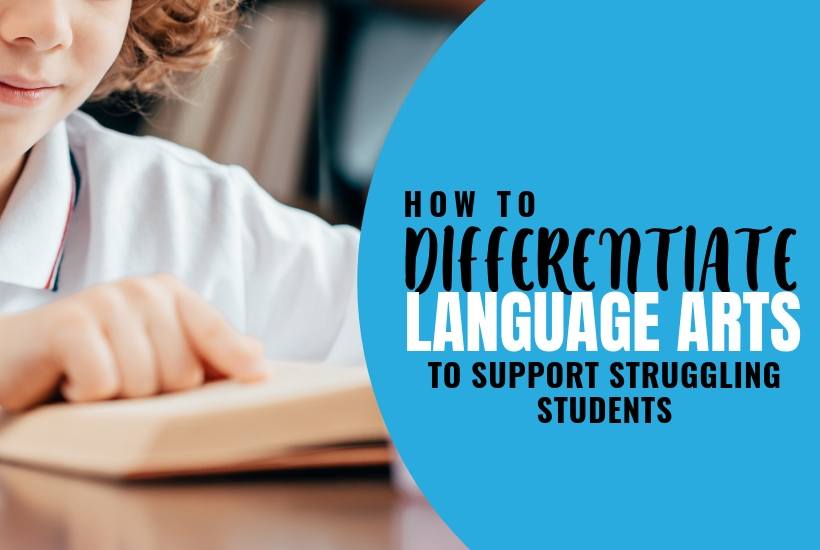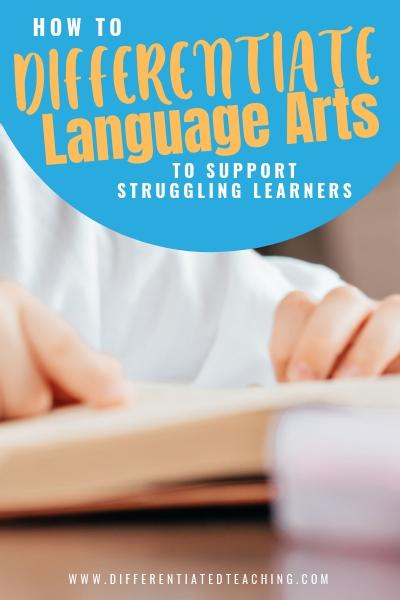Differentiation for struggling readers: Here’s what you need to know
Our classrooms are filled with students who have a wide range of abilities and needs. Identifying struggling readers and providing high-quality intervention isn’t enough. Teachers need to know how to differentiate instruction and reading tasks so that struggling readers don’t fall more behind while they are working to catch up. Reading difficulties are especially challenging because so much of our upper elementary curriculum is tied to being able to read and comprehend. Keep reading to find some ideas for differentiation for struggling readers to help them get the most from your instruction and activities.

Identifying how to support struggling readers – not all struggling readers need the same things.
Regardless of whether students are just beginning the intervention process or have been identified with a disability and receiving services, there are some things you need to do to help your struggling readers.
The first is to look at any assessment data you’ve collected or has been passed along from prior teachers or through the RTI or special education process. This data should include information on the core areas of reading including: decoding, fluency, comprehension, and vocabulary.
If this information isn’t readily available, you should plan to collect it yourself.
I’ve shared some free, quick screening tools that can be useful in my article A Teacher’s Guide to Universal Screening. These screeners can give you a good starting point for where you might need to dig deeper to assess for gaps.
Knowing where students have gaps allows us to better target interventions and create a positive learning environment. It is also essential information for helping students access instruction Tier 1 while they receive support to fill those gaps.
Examples of disabilities that can impact reading
Some students will come to your class already identified as having a disability. These students come with an IEP or 504 plan, which can help guide your instructional planning and differentiation.
Some examples of disabilities that impact a student’s reading abilities include:
- Dyslexia – a disability that impacts phonological processing
- Expressive Language Disorder – when students struggle with speaking which can also impact fluency and accuracy while reading aloud
- Receptive Language Disorder – when students have a difficult time taking in the information that is being told to them which can impact when others are reading aloud in the classroom
- Visual Processing Disorder– when students have a difficult time taking in the information that they see which can impact when they are reading independently
- Attention Deficit Disorder – when students struggle to focus and stay on task, which can impact their ability to attend to text, limit short-term recall, and impact how the student processes information.
Differentiation for struggling readers: Strategies & Accommodations
Daily intervention support is necessary for struggling readers, but we must also find ways to support them during regular instruction. Differentiated instruction strategies can be a useful tool for bridging the gap.
We all know that interventions require time to be successful. We must think about how we can help the scaffold supports so our struggling students can do their best while they are building missing skills.
Here are several strategies for supporting your struggling readers, along with some suggestions for when to use them.

Differentiating for struggling readers with audiobooks.
Audiobooks can be borrowed from your local or school library. There are a number of websites that also offer free digital read alouds.
However, these free sites can be somewhat limited in what they offer. A wider selection of texts is available at sites like Bookshare and Learning Ally if you have students already identified as having a reading disability.
Audiobooks are a great strategy to help students who struggle with reading fluency or decoding. They allow students to focus on building comprehension skills without the barrier these gaps in foundational skills create.
Allow oral responses.
When students struggle with writing, it can be difficult to determine their true understanding. Because writing is laborious, these students often have a large pile of unfinished work and struggle to keep up.
This unfinished work can prevent us from truly assessing understanding. Oral responses can be a huge support for students with learning disabilities or receiving reading interventions. It can also be a great way to gather consistent formative assessment data. This allows us to reteach before more gaps occur.
While you might have students work to read passages or stories that are at their level, you can allow oral questions and responses to make sure you can gauge understanding quickly and effectively.
Consider materials with special fonts.
Some students struggle to track or get lost when there is lots of text on a page. Selecting books with large text or books that use special fonts, like Dyslexie, can be a useful strategy for helping prevent overwhelm and making sure these students can access text.
You can also download and use these fonts if you create worksheets or printables for your classroom. The research has identified Dyslexie, Open Dyslexia, and Comic Sans as ideal fonts for struggling readers with dyslexia. All three are free for download and personal use, but Comic Sans is already available on most computers.
Use tools to help students track text.
Colored overlays and reading guide strips are both tools that can help struggling readers. Colored overlays are helpful for some students who are having trouble. If students perceive the words to be moving on the paper, a colored overlay can help reduce this issue.
Reading guide strips can help students who skip lines or have difficulty keeping their place in the text.
Reach out to your campus special education teacher or dyslexia specialist to see whether they have these tools available.
Break up reading tasks.
Whether you choose to give students regular breaks or break reading tasks into smaller chunks, breaks are a great strategy. They help prevent overwhelm and keep students on-task and engaged. It can also help students understand more of what they read.
The cognitive effort struggling readers put forth to read and comprehend text is enormous compared to their peers. This often leads them to give up, start guessing, or even copy neighbors when tasks feel too hard.
Breaking up the work into smaller chunks can help remedy some of this. It also allows you to regularly check for understanding and clarify before the student moves forward.
Pre-teach and highlight challenging vocabulary.
For some readers, multi-syllable words or new vocabulary can be a barrier to progress in class. These students are often receiving interventions for decoding. Therefore, they need tools to help them get by while these skills continue to develop.
Pre-teaching vocabulary can be a huge help. Highlighting the challenging vocabulary in the text before reading can help students tackle words efficiently. This can also be another tool for preventing overwhelm that can stop progress.
Help students see themselves in the books you make available.
While this really isn’t a differentiation strategy, it can be really helpful in keeping struggling readers motivated and helping them feel like they aren’t alone.
There are lots of books with the theme of embracing differences. The book A Fish in a Tree by Lynda Mullaly Hunt is an especially good book for struggling readers to read (or listen to). The main character is a girl who has difficulty with reading, and she gives lots of insight into her perception of the world and how she feels about being different.
If you decide to use this book for book clubs or small groups, I’ve got a great novel study that is both approachable and engaging for struggling students.
You can grab it here: Fish in a Tree Novel Study.
Why you need to be differentiating for struggling readers
Supporting struggling readers and keeping them engaged in reading (and school) can be a challenge for even the most seasoned teacher.
By implementing these differentiated learning strategies you can reduce overwhelm for struggling students during grade-level reading instruction.







